Statistical Analysis Report: Earnings, Deliveries, and Cost Efficiency
VerifiedAdded on 2020/10/22
|19
|2810
|374
Report
AI Summary
This report presents a comprehensive statistical analysis encompassing various aspects of management, including earnings, deliveries, and cost efficiency. It begins with an introduction to statistical methods and their importance in financial analysis, followed by a detailed examination of male and female earnings from 2010 to 2016, utilizing tables and charts to illustrate trends and differences. The report further explores data from the Office of National Statistics, focusing on gaps in earnings between finance and education sectors, and the pay of social and healthcare staff versus administrative staff. Task 2 delves into the calculation of the median using Ogive charts, along with the calculation of standard deviation and mean. The report then proceeds to Task 3, which addresses cost-efficient delivery situations, including the calculation of the Economic Order Quantity (EOQ) and total variable costs. Finally, Task 4 utilizes line and Ogive charts to represent the data, followed by a conclusion summarizing the key findings and insights. References are provided at the end.
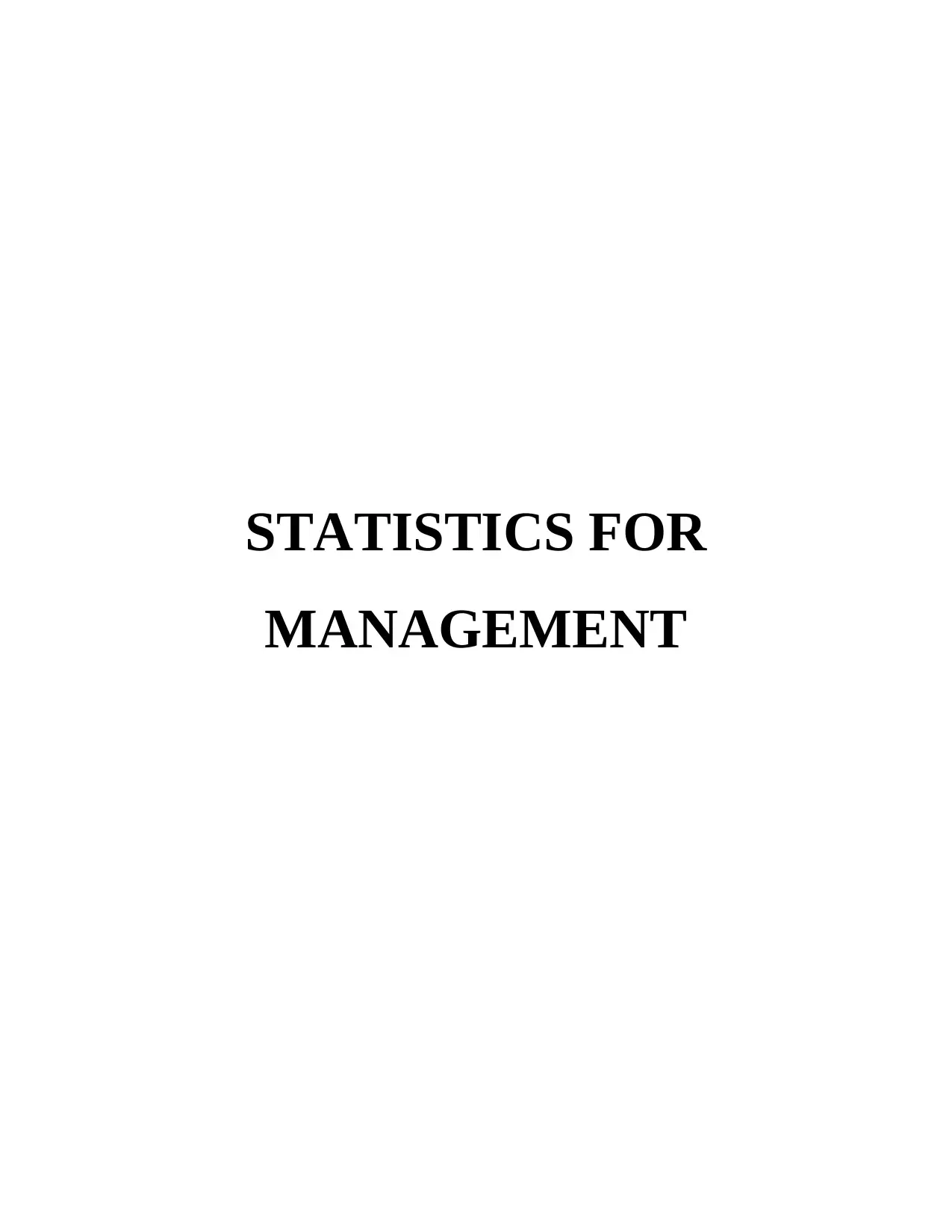
STATISTICS FOR
MANAGEMENT
MANAGEMENT
Paraphrase This Document
Need a fresh take? Get an instant paraphrase of this document with our AI Paraphraser
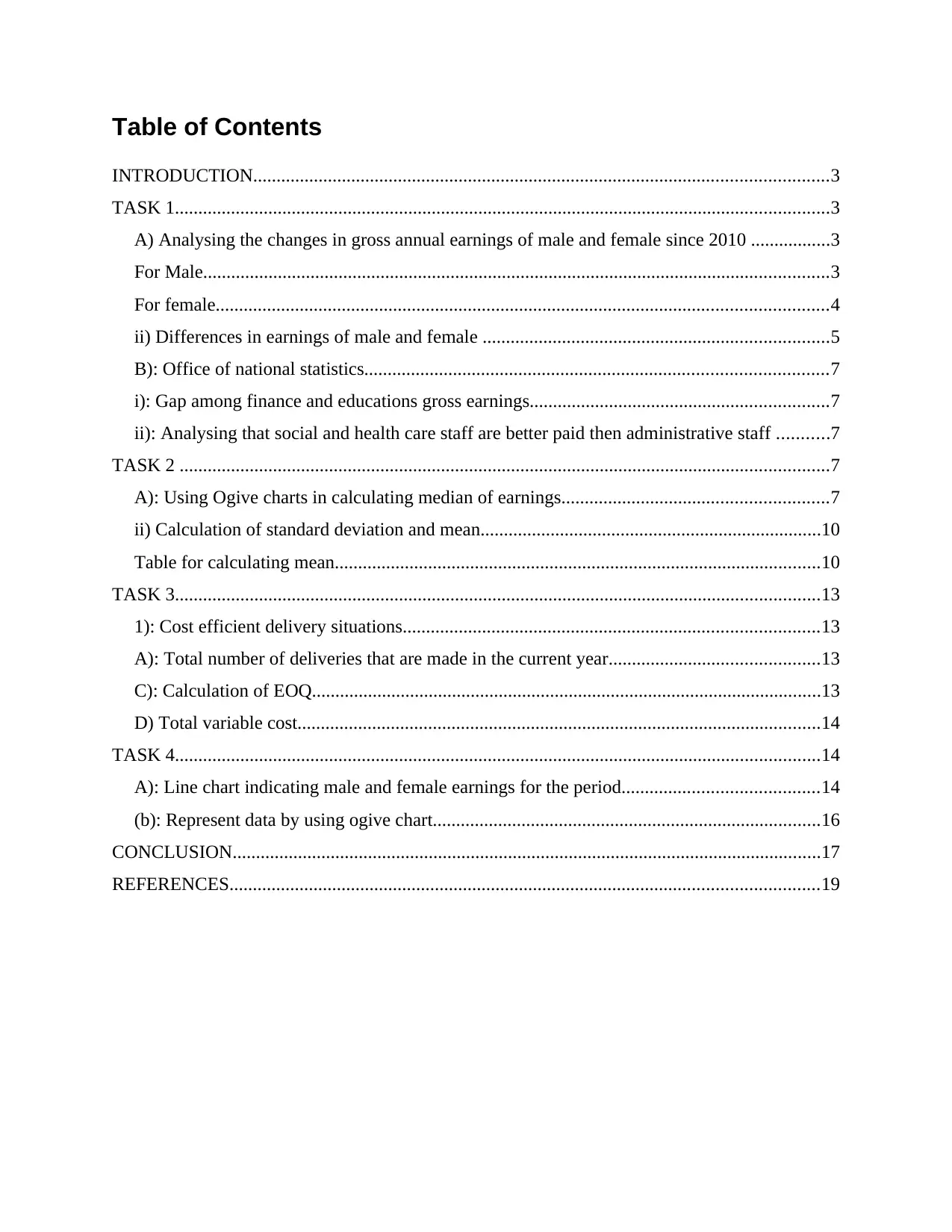
Table of Contents
INTRODUCTION...........................................................................................................................3
TASK 1............................................................................................................................................3
A) Analysing the changes in gross annual earnings of male and female since 2010 .................3
For Male......................................................................................................................................3
For female...................................................................................................................................4
ii) Differences in earnings of male and female ..........................................................................5
B): Office of national statistics...................................................................................................7
i): Gap among finance and educations gross earnings................................................................7
ii): Analysing that social and health care staff are better paid then administrative staff ...........7
TASK 2 ...........................................................................................................................................7
A): Using Ogive charts in calculating median of earnings.........................................................7
ii) Calculation of standard deviation and mean.........................................................................10
Table for calculating mean........................................................................................................10
TASK 3..........................................................................................................................................13
1): Cost efficient delivery situations.........................................................................................13
A): Total number of deliveries that are made in the current year.............................................13
C): Calculation of EOQ.............................................................................................................13
D) Total variable cost................................................................................................................14
TASK 4..........................................................................................................................................14
A): Line chart indicating male and female earnings for the period..........................................14
(b): Represent data by using ogive chart...................................................................................16
CONCLUSION..............................................................................................................................17
REFERENCES..............................................................................................................................19
INTRODUCTION...........................................................................................................................3
TASK 1............................................................................................................................................3
A) Analysing the changes in gross annual earnings of male and female since 2010 .................3
For Male......................................................................................................................................3
For female...................................................................................................................................4
ii) Differences in earnings of male and female ..........................................................................5
B): Office of national statistics...................................................................................................7
i): Gap among finance and educations gross earnings................................................................7
ii): Analysing that social and health care staff are better paid then administrative staff ...........7
TASK 2 ...........................................................................................................................................7
A): Using Ogive charts in calculating median of earnings.........................................................7
ii) Calculation of standard deviation and mean.........................................................................10
Table for calculating mean........................................................................................................10
TASK 3..........................................................................................................................................13
1): Cost efficient delivery situations.........................................................................................13
A): Total number of deliveries that are made in the current year.............................................13
C): Calculation of EOQ.............................................................................................................13
D) Total variable cost................................................................................................................14
TASK 4..........................................................................................................................................14
A): Line chart indicating male and female earnings for the period..........................................14
(b): Represent data by using ogive chart...................................................................................16
CONCLUSION..............................................................................................................................17
REFERENCES..............................................................................................................................19
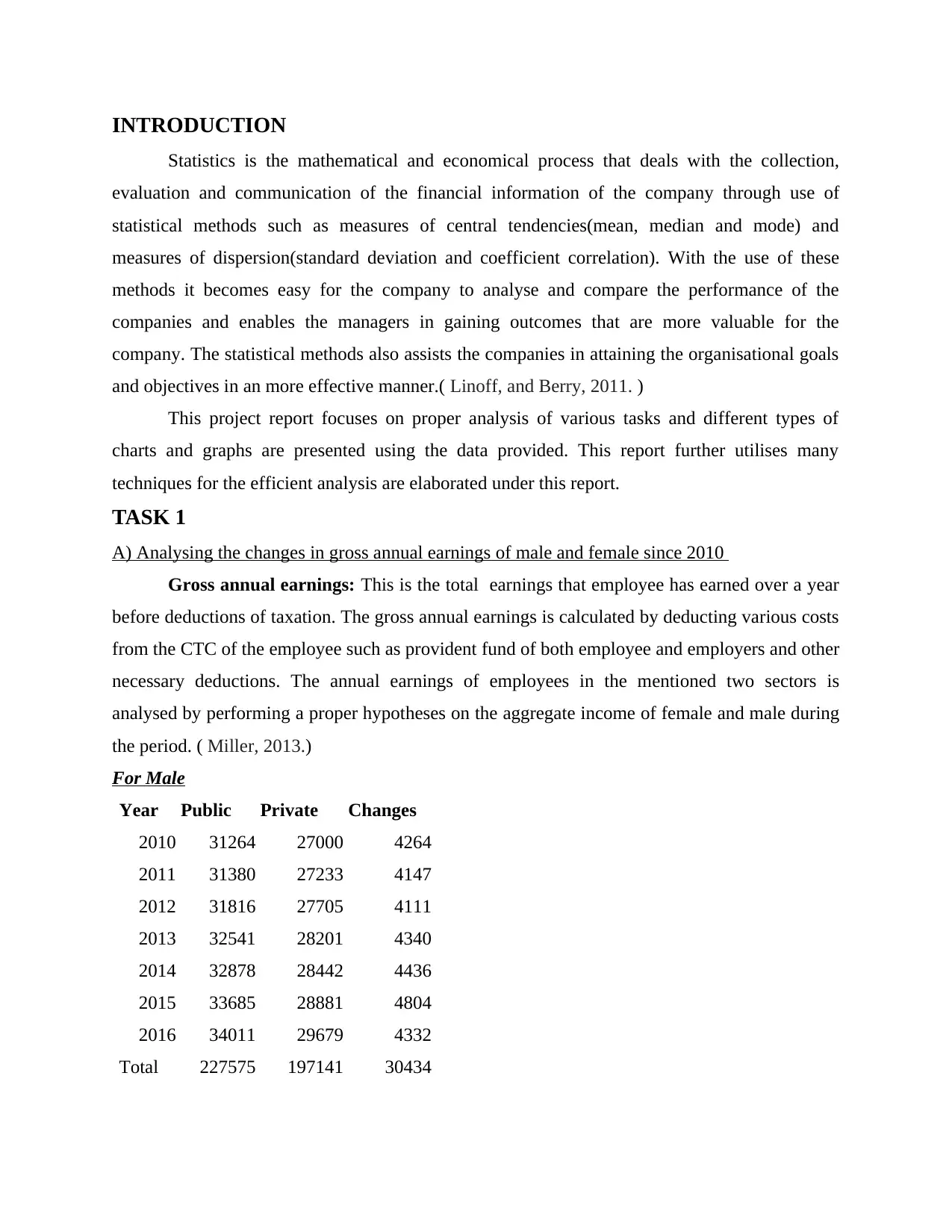
INTRODUCTION
Statistics is the mathematical and economical process that deals with the collection,
evaluation and communication of the financial information of the company through use of
statistical methods such as measures of central tendencies(mean, median and mode) and
measures of dispersion(standard deviation and coefficient correlation). With the use of these
methods it becomes easy for the company to analyse and compare the performance of the
companies and enables the managers in gaining outcomes that are more valuable for the
company. The statistical methods also assists the companies in attaining the organisational goals
and objectives in an more effective manner.( Linoff, and Berry, 2011. )
This project report focuses on proper analysis of various tasks and different types of
charts and graphs are presented using the data provided. This report further utilises many
techniques for the efficient analysis are elaborated under this report.
TASK 1
A) Analysing the changes in gross annual earnings of male and female since 2010
Gross annual earnings: This is the total earnings that employee has earned over a year
before deductions of taxation. The gross annual earnings is calculated by deducting various costs
from the CTC of the employee such as provident fund of both employee and employers and other
necessary deductions. The annual earnings of employees in the mentioned two sectors is
analysed by performing a proper hypotheses on the aggregate income of female and male during
the period. ( Miller, 2013.)
For Male
Year Public Private Changes
2010 31264 27000 4264
2011 31380 27233 4147
2012 31816 27705 4111
2013 32541 28201 4340
2014 32878 28442 4436
2015 33685 28881 4804
2016 34011 29679 4332
Total 227575 197141 30434
Statistics is the mathematical and economical process that deals with the collection,
evaluation and communication of the financial information of the company through use of
statistical methods such as measures of central tendencies(mean, median and mode) and
measures of dispersion(standard deviation and coefficient correlation). With the use of these
methods it becomes easy for the company to analyse and compare the performance of the
companies and enables the managers in gaining outcomes that are more valuable for the
company. The statistical methods also assists the companies in attaining the organisational goals
and objectives in an more effective manner.( Linoff, and Berry, 2011. )
This project report focuses on proper analysis of various tasks and different types of
charts and graphs are presented using the data provided. This report further utilises many
techniques for the efficient analysis are elaborated under this report.
TASK 1
A) Analysing the changes in gross annual earnings of male and female since 2010
Gross annual earnings: This is the total earnings that employee has earned over a year
before deductions of taxation. The gross annual earnings is calculated by deducting various costs
from the CTC of the employee such as provident fund of both employee and employers and other
necessary deductions. The annual earnings of employees in the mentioned two sectors is
analysed by performing a proper hypotheses on the aggregate income of female and male during
the period. ( Miller, 2013.)
For Male
Year Public Private Changes
2010 31264 27000 4264
2011 31380 27233 4147
2012 31816 27705 4111
2013 32541 28201 4340
2014 32878 28442 4436
2015 33685 28881 4804
2016 34011 29679 4332
Total 227575 197141 30434
⊘ This is a preview!⊘
Do you want full access?
Subscribe today to unlock all pages.

Trusted by 1+ million students worldwide
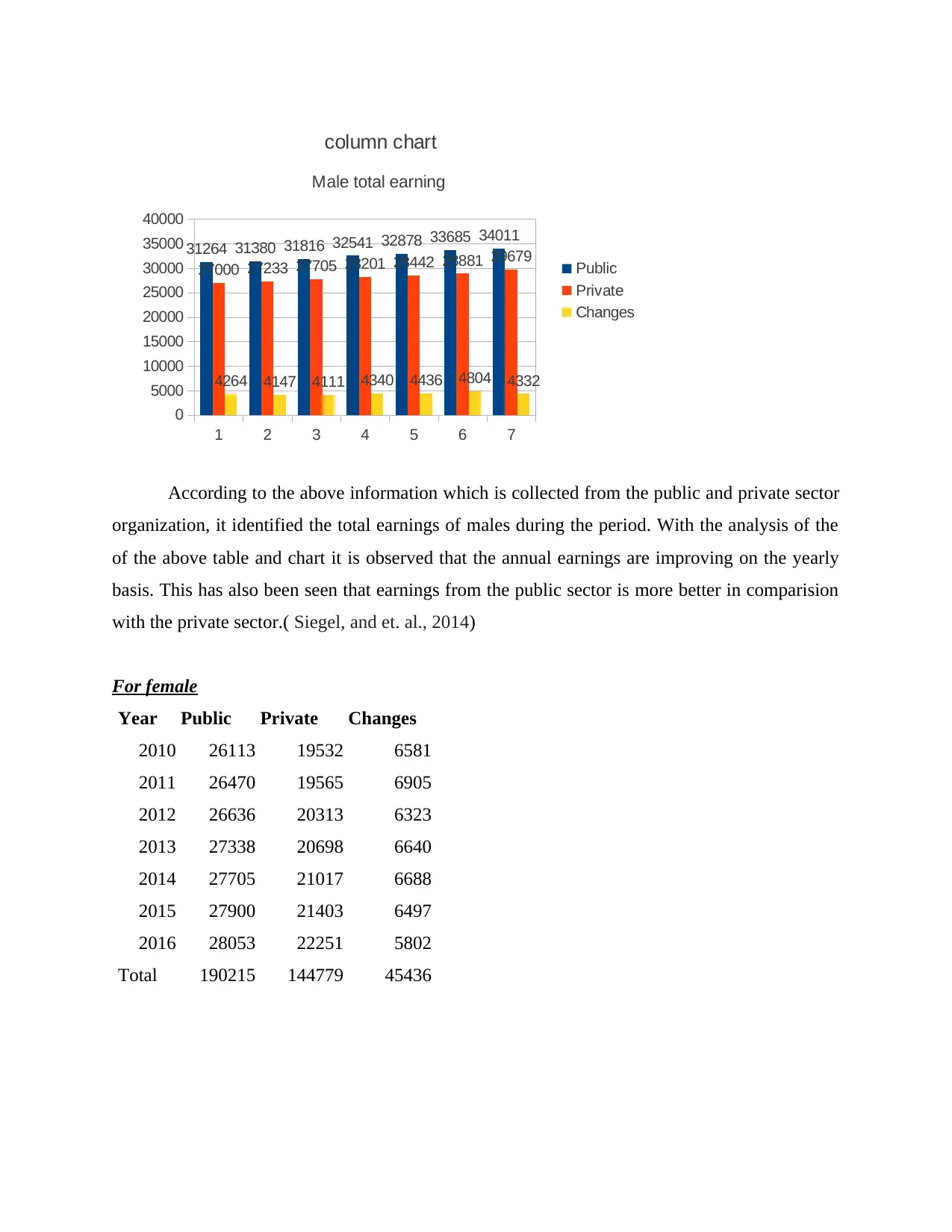
1 2 3 4 5 6 7
0
5000
10000
15000
20000
25000
30000
35000
40000
31264 31380 31816 32541 32878 33685 34011
27000 27233 27705 28201 28442 28881 29679
4264 4147 4111 4340 4436 4804 4332
column chart
Male total earning
Public
Private
Changes
According to the above information which is collected from the public and private sector
organization, it identified the total earnings of males during the period. With the analysis of the
of the above table and chart it is observed that the annual earnings are improving on the yearly
basis. This has also been seen that earnings from the public sector is more better in comparision
with the private sector.( Siegel, and et. al., 2014)
For female
Year Public Private Changes
2010 26113 19532 6581
2011 26470 19565 6905
2012 26636 20313 6323
2013 27338 20698 6640
2014 27705 21017 6688
2015 27900 21403 6497
2016 28053 22251 5802
Total 190215 144779 45436
0
5000
10000
15000
20000
25000
30000
35000
40000
31264 31380 31816 32541 32878 33685 34011
27000 27233 27705 28201 28442 28881 29679
4264 4147 4111 4340 4436 4804 4332
column chart
Male total earning
Public
Private
Changes
According to the above information which is collected from the public and private sector
organization, it identified the total earnings of males during the period. With the analysis of the
of the above table and chart it is observed that the annual earnings are improving on the yearly
basis. This has also been seen that earnings from the public sector is more better in comparision
with the private sector.( Siegel, and et. al., 2014)
For female
Year Public Private Changes
2010 26113 19532 6581
2011 26470 19565 6905
2012 26636 20313 6323
2013 27338 20698 6640
2014 27705 21017 6688
2015 27900 21403 6497
2016 28053 22251 5802
Total 190215 144779 45436
Paraphrase This Document
Need a fresh take? Get an instant paraphrase of this document with our AI Paraphraser
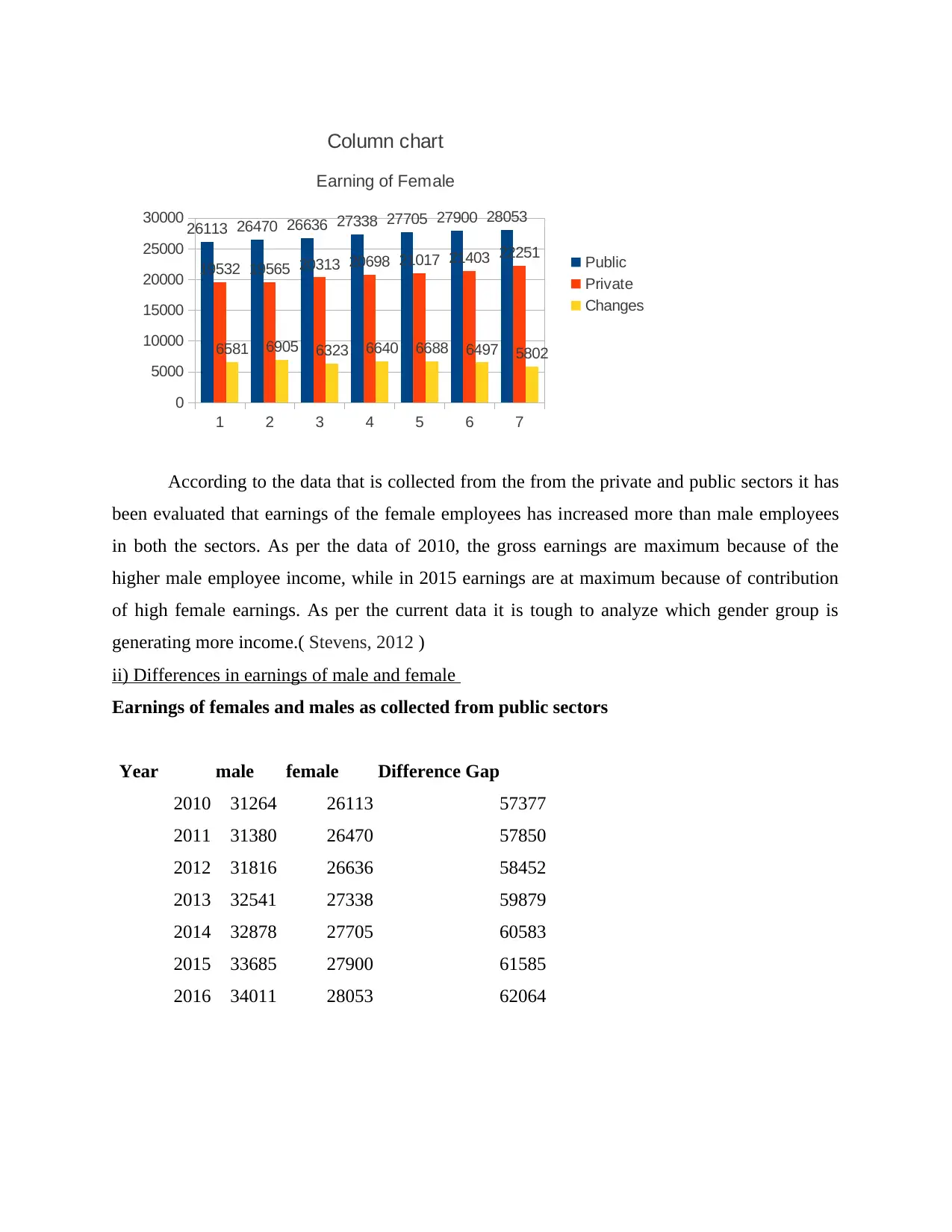
1 2 3 4 5 6 7
0
5000
10000
15000
20000
25000
30000 26113 26470 26636 27338 27705 27900 28053
19532 19565 20313 20698 21017 21403 22251
6581 6905 6323 6640 6688 6497 5802
Column chart
Earning of Female
Public
Private
Changes
According to the data that is collected from the from the private and public sectors it has
been evaluated that earnings of the female employees has increased more than male employees
in both the sectors. As per the data of 2010, the gross earnings are maximum because of the
higher male employee income, while in 2015 earnings are at maximum because of contribution
of high female earnings. As per the current data it is tough to analyze which gender group is
generating more income.( Stevens, 2012 )
ii) Differences in earnings of male and female
Earnings of females and males as collected from public sectors
Year male female Difference Gap
2010 31264 26113 57377
2011 31380 26470 57850
2012 31816 26636 58452
2013 32541 27338 59879
2014 32878 27705 60583
2015 33685 27900 61585
2016 34011 28053 62064
0
5000
10000
15000
20000
25000
30000 26113 26470 26636 27338 27705 27900 28053
19532 19565 20313 20698 21017 21403 22251
6581 6905 6323 6640 6688 6497 5802
Column chart
Earning of Female
Public
Private
Changes
According to the data that is collected from the from the private and public sectors it has
been evaluated that earnings of the female employees has increased more than male employees
in both the sectors. As per the data of 2010, the gross earnings are maximum because of the
higher male employee income, while in 2015 earnings are at maximum because of contribution
of high female earnings. As per the current data it is tough to analyze which gender group is
generating more income.( Stevens, 2012 )
ii) Differences in earnings of male and female
Earnings of females and males as collected from public sectors
Year male female Difference Gap
2010 31264 26113 57377
2011 31380 26470 57850
2012 31816 26636 58452
2013 32541 27338 59879
2014 32878 27705 60583
2015 33685 27900 61585
2016 34011 28053 62064
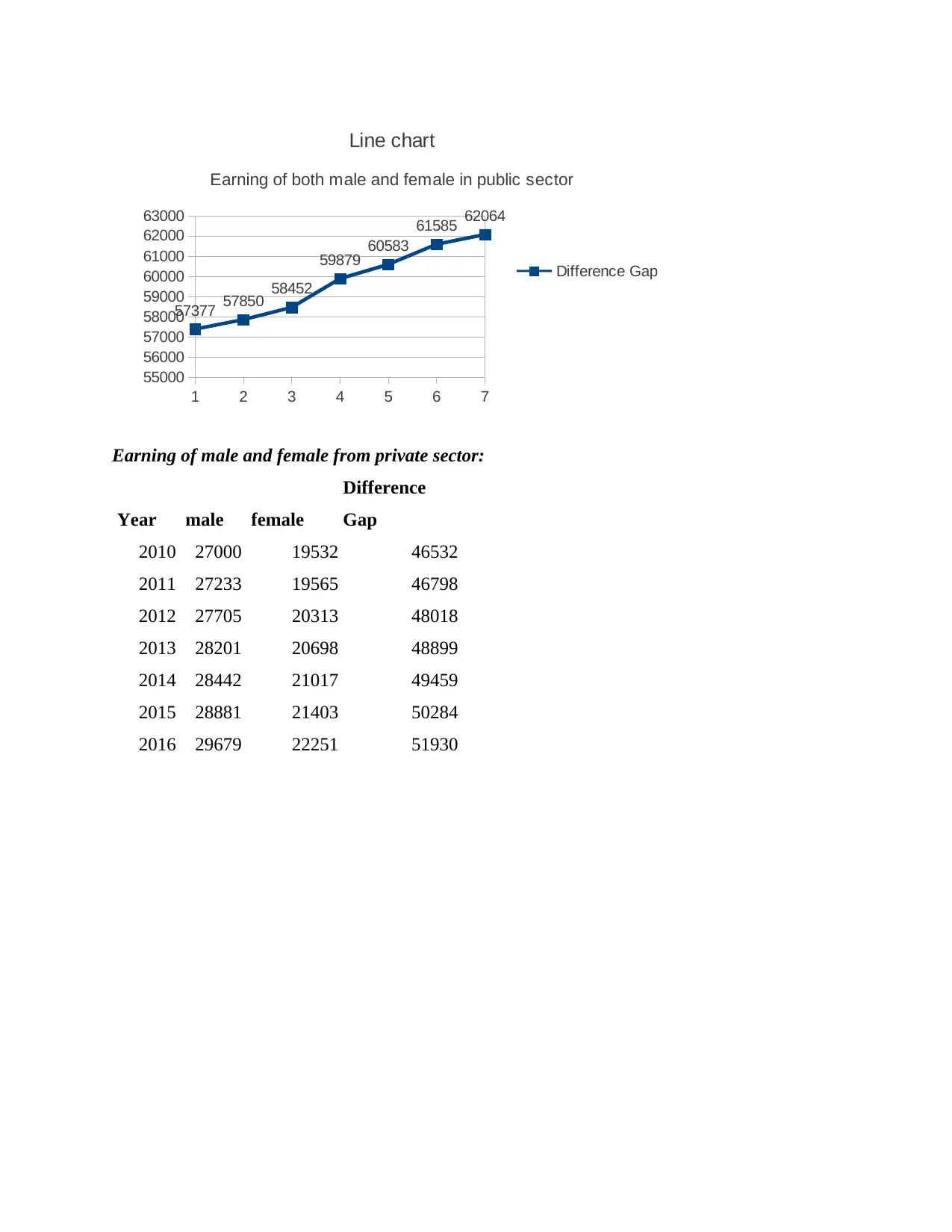
1 2 3 4 5 6 7
55000
56000
57000
58000
59000
60000
61000
62000
63000
57377 57850 58452
59879 60583
61585 62064
Line chart
Earning of both male and female in public sector
Difference Gap
Earning of male and female from private sector:
Year male female
Difference
Gap
2010 27000 19532 46532
2011 27233 19565 46798
2012 27705 20313 48018
2013 28201 20698 48899
2014 28442 21017 49459
2015 28881 21403 50284
2016 29679 22251 51930
55000
56000
57000
58000
59000
60000
61000
62000
63000
57377 57850 58452
59879 60583
61585 62064
Line chart
Earning of both male and female in public sector
Difference Gap
Earning of male and female from private sector:
Year male female
Difference
Gap
2010 27000 19532 46532
2011 27233 19565 46798
2012 27705 20313 48018
2013 28201 20698 48899
2014 28442 21017 49459
2015 28881 21403 50284
2016 29679 22251 51930
⊘ This is a preview!⊘
Do you want full access?
Subscribe today to unlock all pages.

Trusted by 1+ million students worldwide
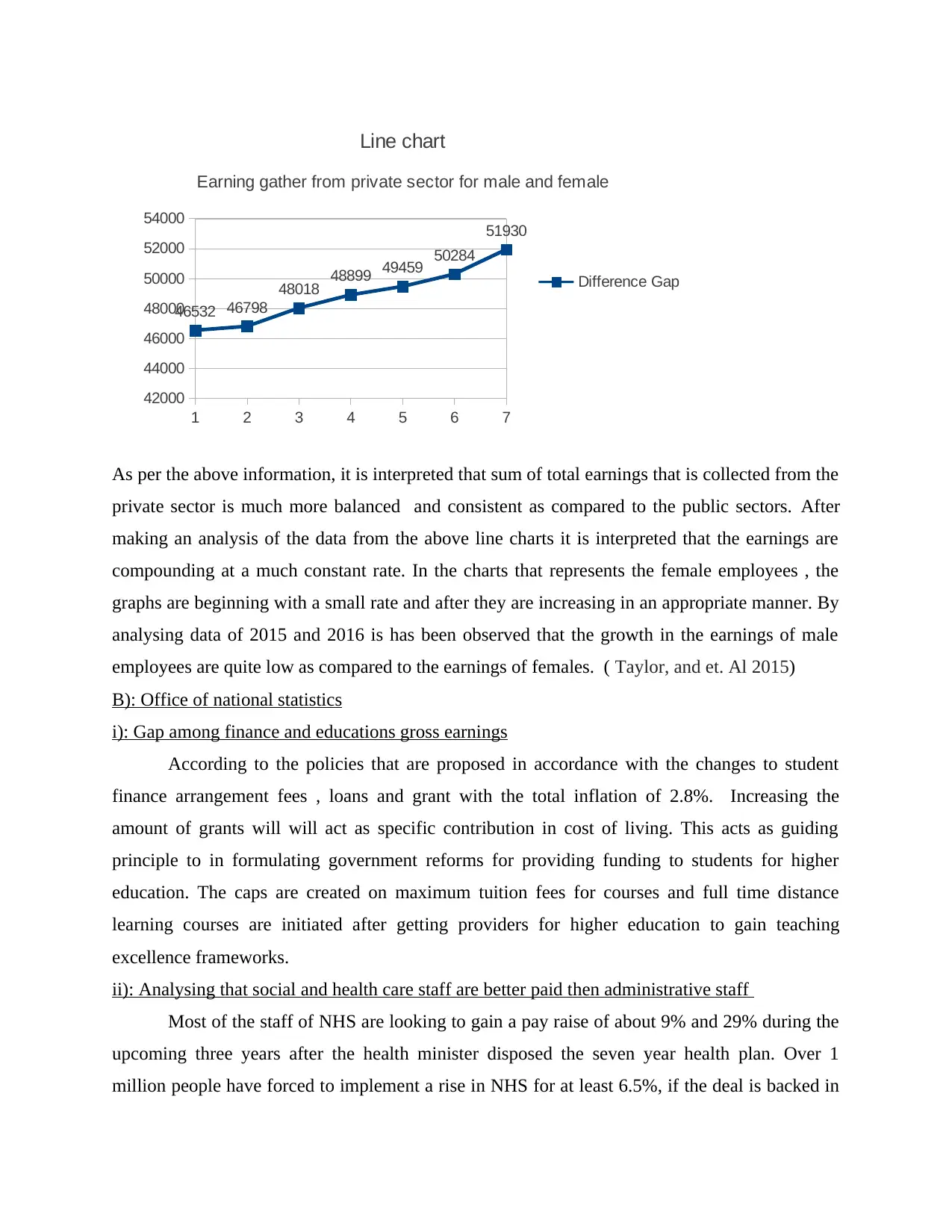
1 2 3 4 5 6 7
42000
44000
46000
48000
50000
52000
54000
46532 46798
48018 48899 49459 50284
51930
Line chart
Earning gather from private sector for male and female
Difference Gap
As per the above information, it is interpreted that sum of total earnings that is collected from the
private sector is much more balanced and consistent as compared to the public sectors. After
making an analysis of the data from the above line charts it is interpreted that the earnings are
compounding at a much constant rate. In the charts that represents the female employees , the
graphs are beginning with a small rate and after they are increasing in an appropriate manner. By
analysing data of 2015 and 2016 is has been observed that the growth in the earnings of male
employees are quite low as compared to the earnings of females. ( Taylor, and et. Al 2015)
B): Office of national statistics
i): Gap among finance and educations gross earnings
According to the policies that are proposed in accordance with the changes to student
finance arrangement fees , loans and grant with the total inflation of 2.8%. Increasing the
amount of grants will will act as specific contribution in cost of living. This acts as guiding
principle to in formulating government reforms for providing funding to students for higher
education. The caps are created on maximum tuition fees for courses and full time distance
learning courses are initiated after getting providers for higher education to gain teaching
excellence frameworks.
ii): Analysing that social and health care staff are better paid then administrative staff
Most of the staff of NHS are looking to gain a pay raise of about 9% and 29% during the
upcoming three years after the health minister disposed the seven year health plan. Over 1
million people have forced to implement a rise in NHS for at least 6.5%, if the deal is backed in
42000
44000
46000
48000
50000
52000
54000
46532 46798
48018 48899 49459 50284
51930
Line chart
Earning gather from private sector for male and female
Difference Gap
As per the above information, it is interpreted that sum of total earnings that is collected from the
private sector is much more balanced and consistent as compared to the public sectors. After
making an analysis of the data from the above line charts it is interpreted that the earnings are
compounding at a much constant rate. In the charts that represents the female employees , the
graphs are beginning with a small rate and after they are increasing in an appropriate manner. By
analysing data of 2015 and 2016 is has been observed that the growth in the earnings of male
employees are quite low as compared to the earnings of females. ( Taylor, and et. Al 2015)
B): Office of national statistics
i): Gap among finance and educations gross earnings
According to the policies that are proposed in accordance with the changes to student
finance arrangement fees , loans and grant with the total inflation of 2.8%. Increasing the
amount of grants will will act as specific contribution in cost of living. This acts as guiding
principle to in formulating government reforms for providing funding to students for higher
education. The caps are created on maximum tuition fees for courses and full time distance
learning courses are initiated after getting providers for higher education to gain teaching
excellence frameworks.
ii): Analysing that social and health care staff are better paid then administrative staff
Most of the staff of NHS are looking to gain a pay raise of about 9% and 29% during the
upcoming three years after the health minister disposed the seven year health plan. Over 1
million people have forced to implement a rise in NHS for at least 6.5%, if the deal is backed in
Paraphrase This Document
Need a fresh take? Get an instant paraphrase of this document with our AI Paraphraser
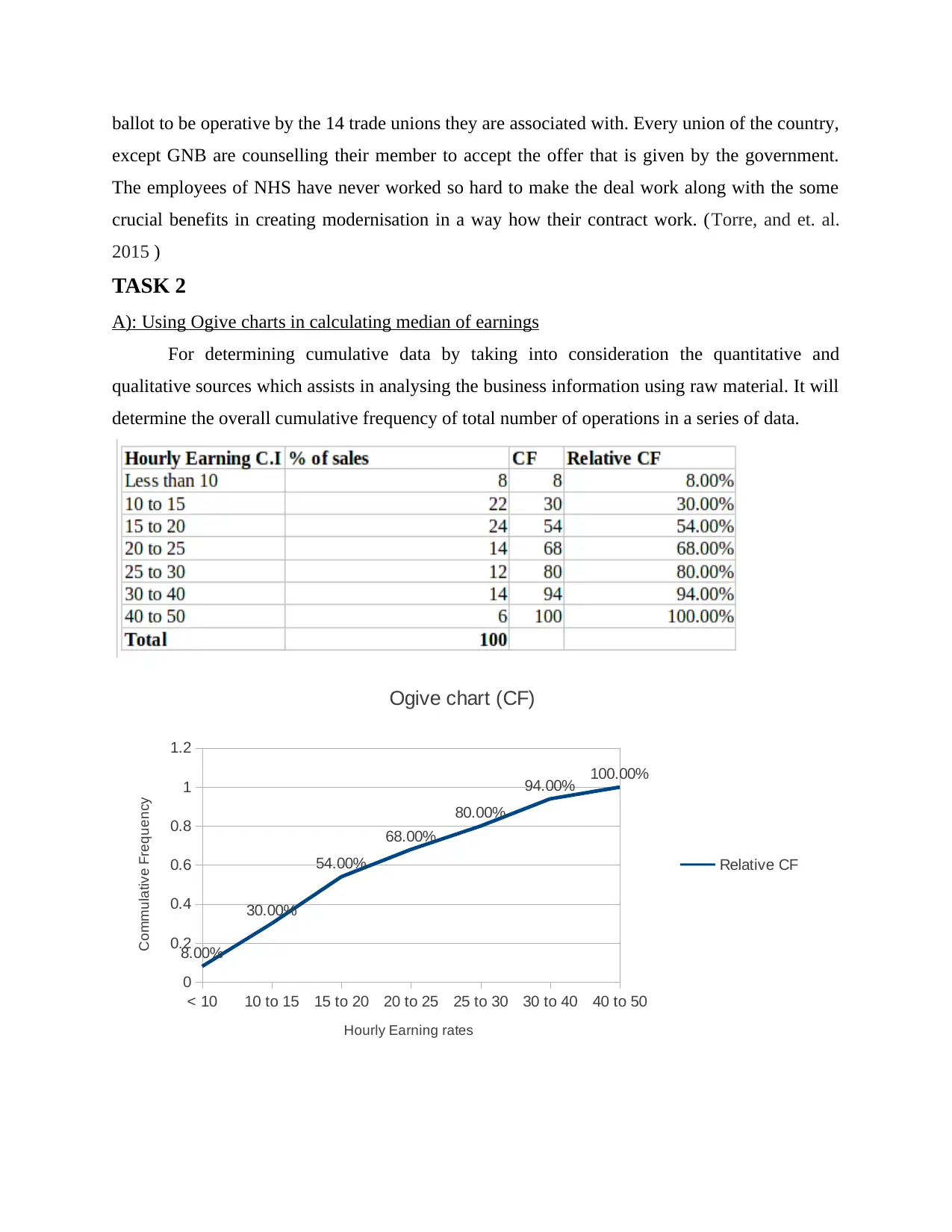
ballot to be operative by the 14 trade unions they are associated with. Every union of the country,
except GNB are counselling their member to accept the offer that is given by the government.
The employees of NHS have never worked so hard to make the deal work along with the some
crucial benefits in creating modernisation in a way how their contract work. (Torre, and et. al.
2015 )
TASK 2
A): Using Ogive charts in calculating median of earnings
For determining cumulative data by taking into consideration the quantitative and
qualitative sources which assists in analysing the business information using raw material. It will
determine the overall cumulative frequency of total number of operations in a series of data.
< 10 10 to 15 15 to 20 20 to 25 25 to 30 30 to 40 40 to 50
0
0.2
0.4
0.6
0.8
1
1.2
8.00%
30.00%
54.00%
68.00%
80.00%
94.00% 100.00%
Ogive chart (CF)
Relative CF
Hourly Earning rates
Commulative Frequency
except GNB are counselling their member to accept the offer that is given by the government.
The employees of NHS have never worked so hard to make the deal work along with the some
crucial benefits in creating modernisation in a way how their contract work. (Torre, and et. al.
2015 )
TASK 2
A): Using Ogive charts in calculating median of earnings
For determining cumulative data by taking into consideration the quantitative and
qualitative sources which assists in analysing the business information using raw material. It will
determine the overall cumulative frequency of total number of operations in a series of data.
< 10 10 to 15 15 to 20 20 to 25 25 to 30 30 to 40 40 to 50
0
0.2
0.4
0.6
0.8
1
1.2
8.00%
30.00%
54.00%
68.00%
80.00%
94.00% 100.00%
Ogive chart (CF)
Relative CF
Hourly Earning rates
Commulative Frequency
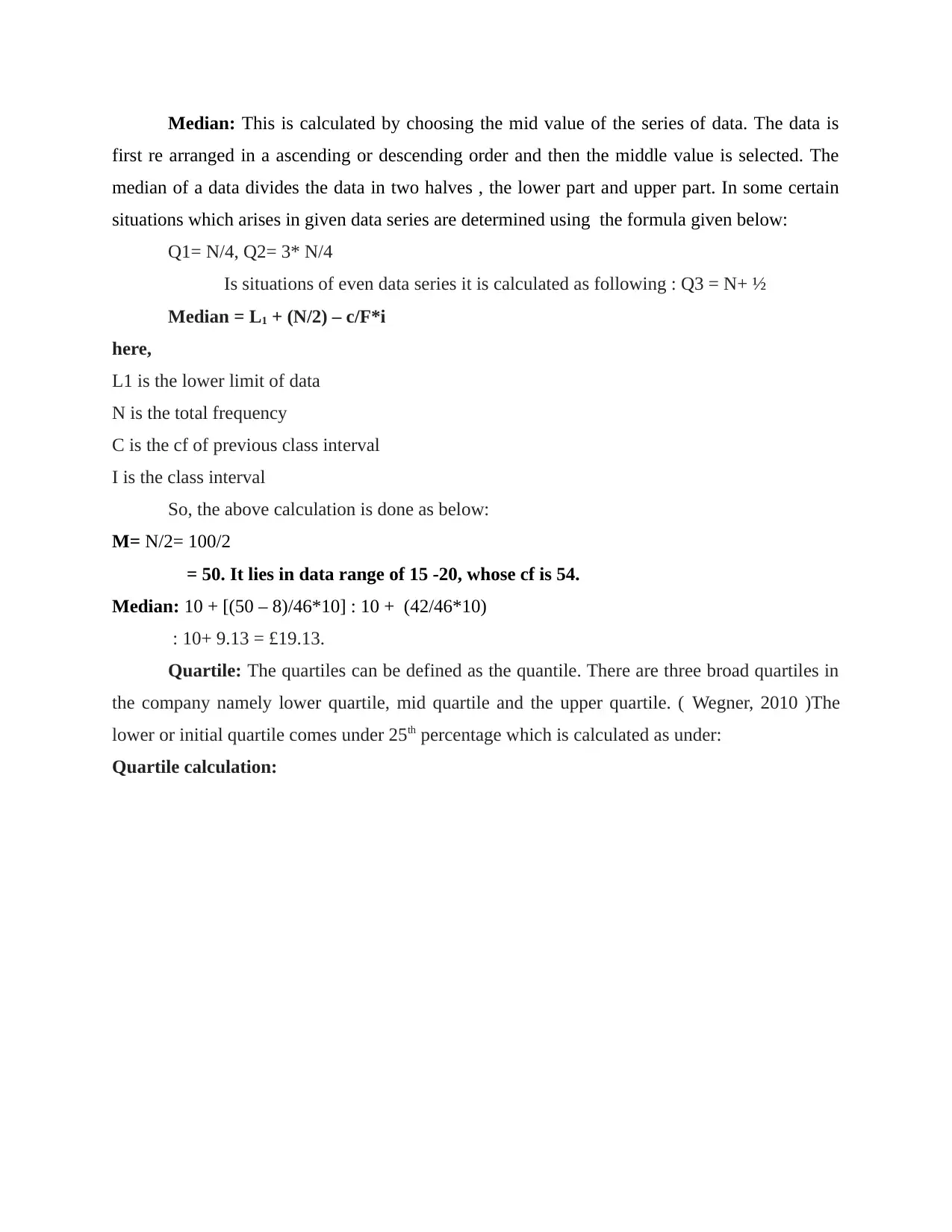
Median: This is calculated by choosing the mid value of the series of data. The data is
first re arranged in a ascending or descending order and then the middle value is selected. The
median of a data divides the data in two halves , the lower part and upper part. In some certain
situations which arises in given data series are determined using the formula given below:
Q1= N/4, Q2= 3* N/4
Is situations of even data series it is calculated as following : Q3 = N+ ½
Median = L1 + (N/2) – c/F*i
here,
L1 is the lower limit of data
N is the total frequency
C is the cf of previous class interval
I is the class interval
So, the above calculation is done as below:
M= N/2= 100/2
= 50. It lies in data range of 15 -20, whose cf is 54.
Median: 10 + [(50 – 8)/46*10] : 10 + (42/46*10)
: 10+ 9.13 = £19.13.
Quartile: The quartiles can be defined as the quantile. There are three broad quartiles in
the company namely lower quartile, mid quartile and the upper quartile. ( Wegner, 2010 )The
lower or initial quartile comes under 25th percentage which is calculated as under:
Quartile calculation:
first re arranged in a ascending or descending order and then the middle value is selected. The
median of a data divides the data in two halves , the lower part and upper part. In some certain
situations which arises in given data series are determined using the formula given below:
Q1= N/4, Q2= 3* N/4
Is situations of even data series it is calculated as following : Q3 = N+ ½
Median = L1 + (N/2) – c/F*i
here,
L1 is the lower limit of data
N is the total frequency
C is the cf of previous class interval
I is the class interval
So, the above calculation is done as below:
M= N/2= 100/2
= 50. It lies in data range of 15 -20, whose cf is 54.
Median: 10 + [(50 – 8)/46*10] : 10 + (42/46*10)
: 10+ 9.13 = £19.13.
Quartile: The quartiles can be defined as the quantile. There are three broad quartiles in
the company namely lower quartile, mid quartile and the upper quartile. ( Wegner, 2010 )The
lower or initial quartile comes under 25th percentage which is calculated as under:
Quartile calculation:
⊘ This is a preview!⊘
Do you want full access?
Subscribe today to unlock all pages.

Trusted by 1+ million students worldwide
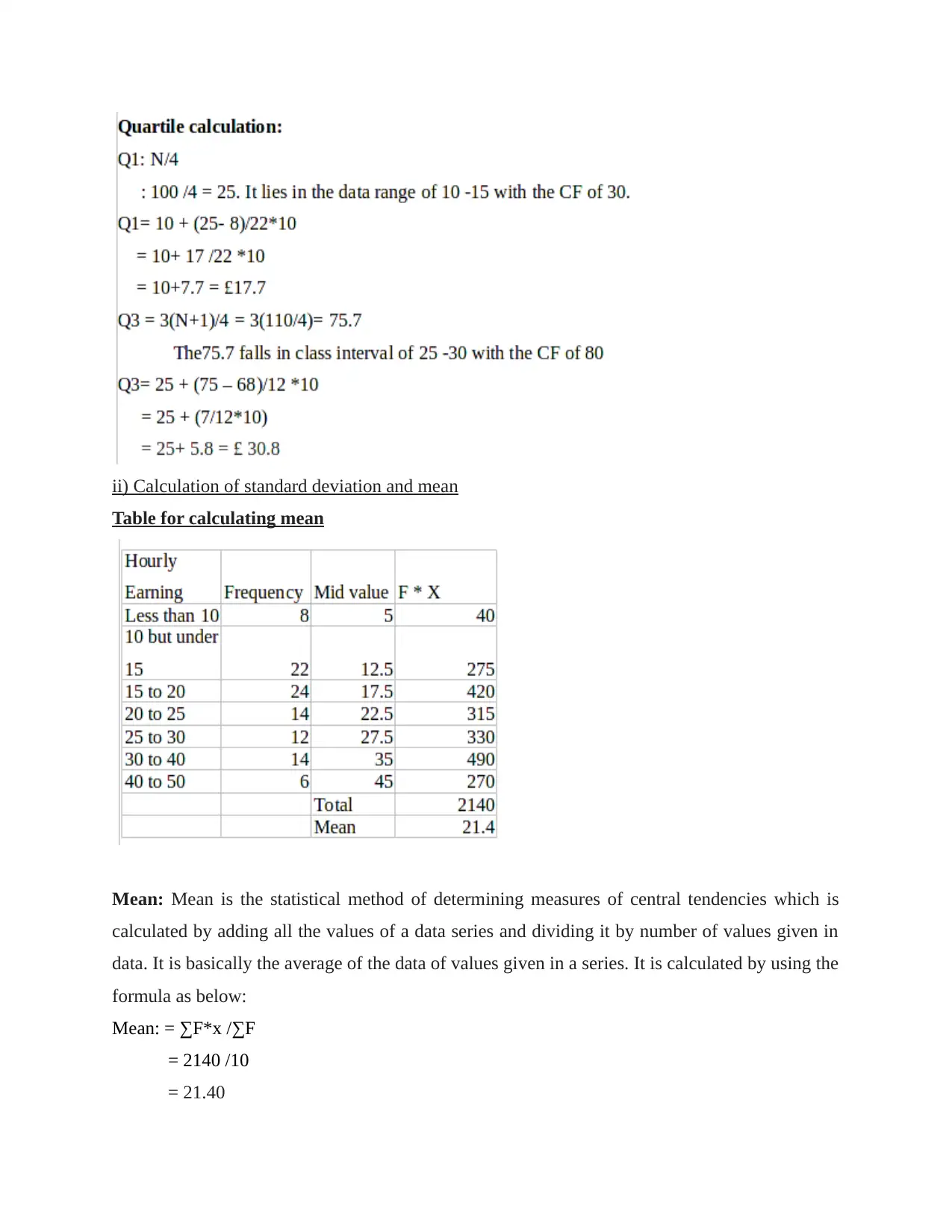
ii) Calculation of standard deviation and mean
Table for calculating mean
Mean: Mean is the statistical method of determining measures of central tendencies which is
calculated by adding all the values of a data series and dividing it by number of values given in
data. It is basically the average of the data of values given in a series. It is calculated by using the
formula as below:
Mean: = ∑F*x /∑F
= 2140 /10
= 21.40
Table for calculating mean
Mean: Mean is the statistical method of determining measures of central tendencies which is
calculated by adding all the values of a data series and dividing it by number of values given in
data. It is basically the average of the data of values given in a series. It is calculated by using the
formula as below:
Mean: = ∑F*x /∑F
= 2140 /10
= 21.40
Paraphrase This Document
Need a fresh take? Get an instant paraphrase of this document with our AI Paraphraser
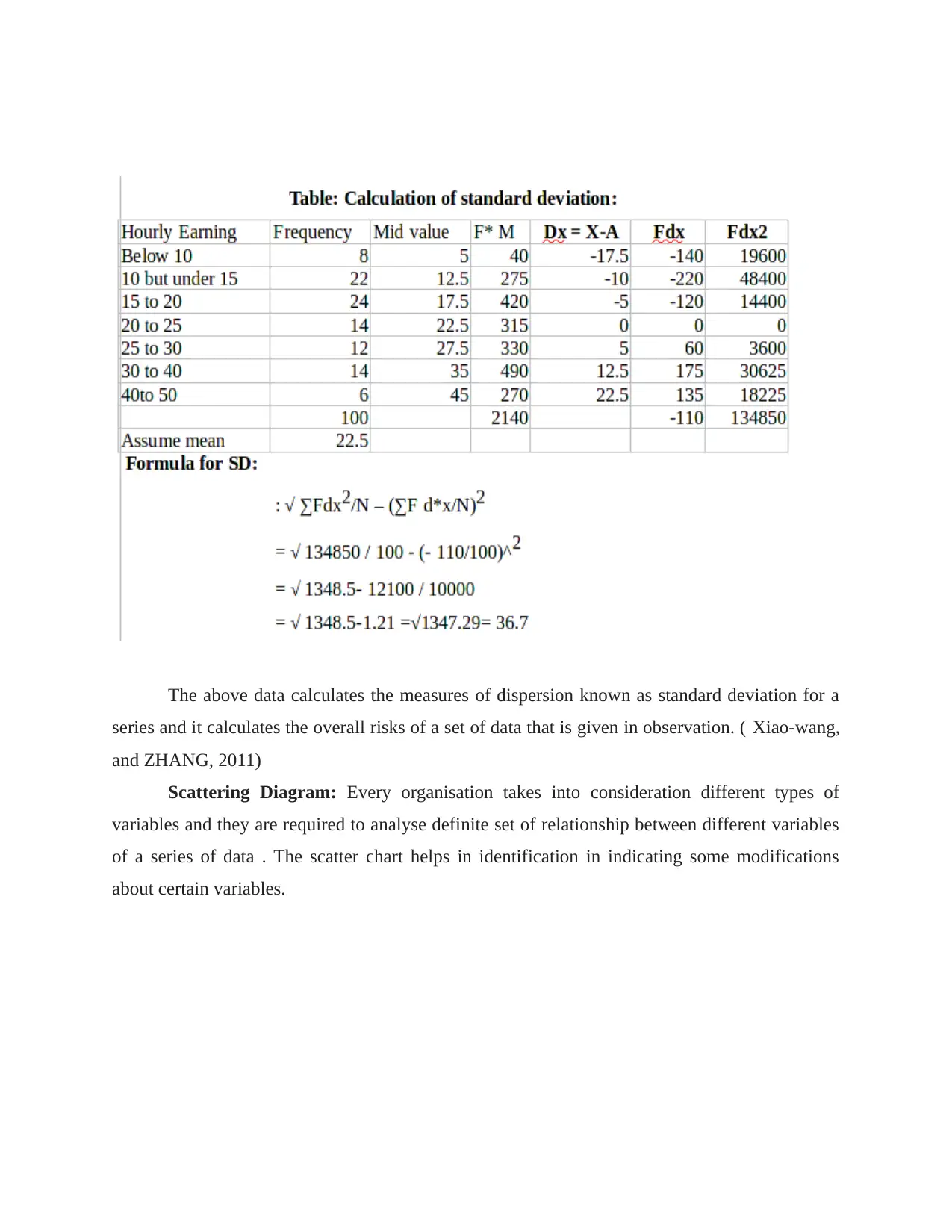
The above data calculates the measures of dispersion known as standard deviation for a
series and it calculates the overall risks of a set of data that is given in observation. ( Xiao-wang,
and ZHANG, 2011)
Scattering Diagram: Every organisation takes into consideration different types of
variables and they are required to analyse definite set of relationship between different variables
of a series of data . The scatter chart helps in identification in indicating some modifications
about certain variables.
series and it calculates the overall risks of a set of data that is given in observation. ( Xiao-wang,
and ZHANG, 2011)
Scattering Diagram: Every organisation takes into consideration different types of
variables and they are required to analyse definite set of relationship between different variables
of a series of data . The scatter chart helps in identification in indicating some modifications
about certain variables.
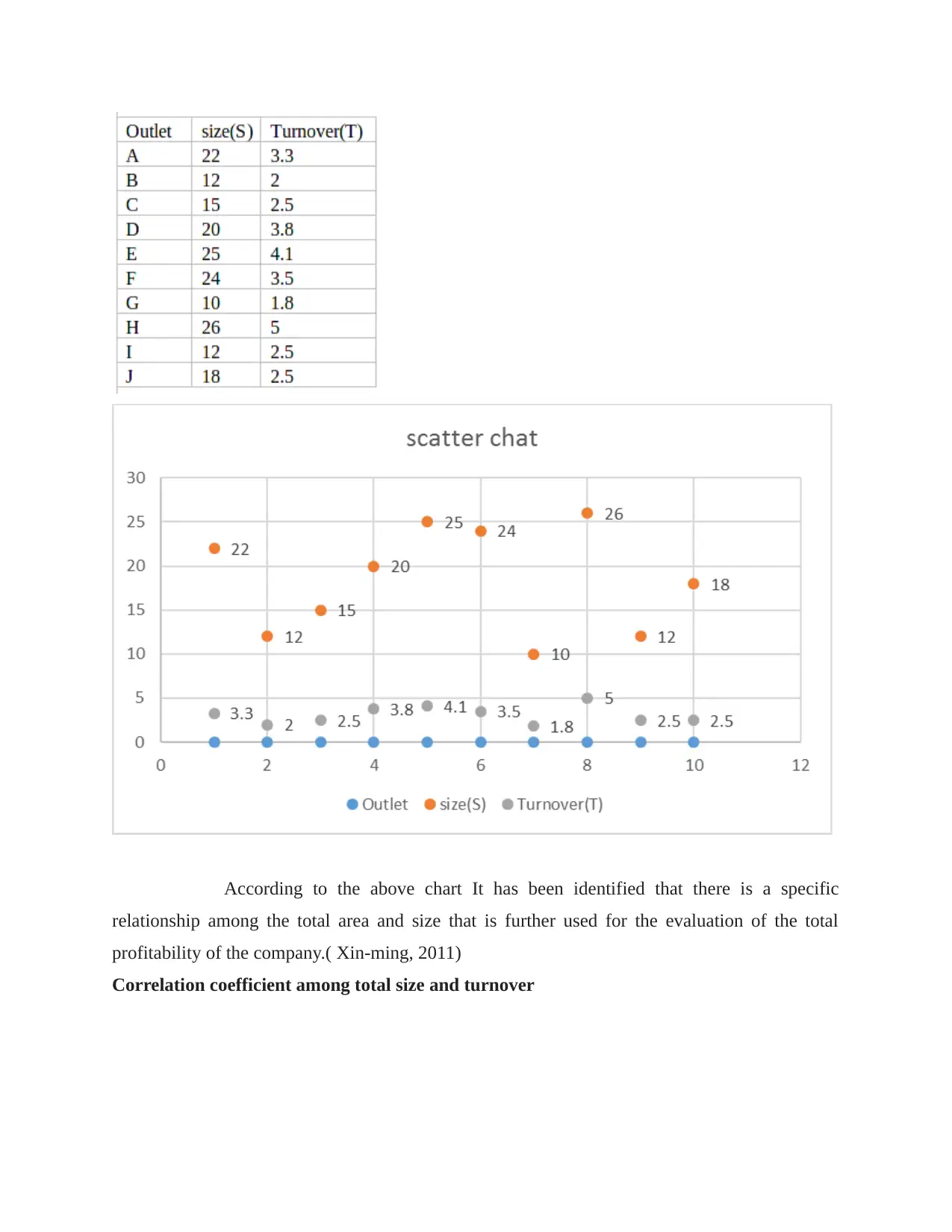
According to the above chart It has been identified that there is a specific
relationship among the total area and size that is further used for the evaluation of the total
profitability of the company.( Xin-ming, 2011)
Correlation coefficient among total size and turnover
relationship among the total area and size that is further used for the evaluation of the total
profitability of the company.( Xin-ming, 2011)
Correlation coefficient among total size and turnover
⊘ This is a preview!⊘
Do you want full access?
Subscribe today to unlock all pages.

Trusted by 1+ million students worldwide
1 out of 19
Related Documents
Your All-in-One AI-Powered Toolkit for Academic Success.
+13062052269
info@desklib.com
Available 24*7 on WhatsApp / Email
![[object Object]](/_next/static/media/star-bottom.7253800d.svg)
Unlock your academic potential
Copyright © 2020–2025 A2Z Services. All Rights Reserved. Developed and managed by ZUCOL.





